 |
|
|
|
|
|
|
| ||||||||||
|
|
|
|
|
|
|
||||
| ||||||||||
|
|
|
|
|
Persons using assistive technology might not be able to fully access information in this file. For assistance, please send e-mail to: mmwrq@cdc.gov. Type 508 Accommodation and the title of the report in the subject line of e-mail. Abortion Surveillance --- United States, 1997Lisa M. Koonin, M.N., M.P.H. Division of Reproductive Health Abstract Problem/Condition: In 1969, CDC began abortion surveillance to document the number and characteristics of women obtaining legal induced abortions, to monitor unintended pregnancy, and to assist efforts to identify and reduce preventable causes of morbidity and mortality associated with abortions. Reporting Period Covered: This report summarizes and reviews information reported to CDC regarding legal induced abortions obtained in the United States in 1997. Description of System: For each year since 1969, CDC has compiled abortion data by state where the abortion occurred. The data are received from 52 reporting areas in the United States: 50 states, the District of Columbia, and New York City. Results: In 1997, a total of 1,186,039 legal abortions were reported to CDC, representing a 3% decrease from the number reported for 1996. The abortion ratio was 306 legal induced abortions per 1,000 live births, and since 1995, the abortion rate has remained at 20 per 1,000 women aged 15--44 years. The availability of information about characteristics of women who obtained an abortion in 1997 varied by state and by the number of states reporting each characteristic. The total number of legal induced abortions by state is reported by state of residence and state of occurrence; characteristics of women obtaining abortions in 1997 are reported by state of occurrence. Women who were undergoing an abortion were more likely to be young (i.e., aged <25 years), white, and unmarried; approximately one half were obtaining an abortion for the first time. More than one half of all abortions for which gestational age was reported (55%) were performed at <8 weeks of gestation, and 88% were performed before 13 weeks. Overall, 18% of abortions were performed at the earliest weeks of gestation (<6 weeks), 18% at 7 weeks of gestation, and 20% at 8 weeks of gestation. From 1992 through 1997, increases have occurred in the percentage of abortions performed at the very early weeks of gestation. Few abortions were provided after 15 weeks of gestation --- 4% of abortions were obtained at 16--20 weeks, and 1.4% were obtained at >21 weeks. A total of 19 reporting areas submitted information regarding abortions performed by medical (nonsurgical) procedures, comprising <1% of procedures reported by all states. Younger women (i.e., aged <24 years) were more likely to obtain abortions later in pregnancy than were older women. Interpretation: From 1990 through 1995, the number of abortions declined each year; in 1996, the number increased slightly, and in 1997, the number of abortions in the United States declined to it lowest level since 1978. Public Health Actions: The number and characteristics of women who obtain abortions in the United States should continue to be monitored so that trends in induced abortion can be assessed and efforts to prevent unintended pregnancy can be evaluated. INTRODUCTIONIn 1969, CDC began abortion surveillance to document the number and characteristics of women obtaining legal induced abortions, to monitor unintended pregnancy, and to assist efforts to identify and reduce preventable causes of morbidity and mortality associated with abortions. This report is based on abortion data for 1997 provided to CDC's National Center for Chronic Disease Prevention and Health Promotion (NCCDPHP), Division of Reproductive Health. METHODSFor 1997, CDC compiled data from 52 reporting areas in the United States: 50 states, the District of Columbia, and New York City. Legal induced abortion was defined as a procedure, performed by a licensed physician or someone acting under the supervision of a licensed physician, that was intended to terminate a suspected or known intrauterine pregnancy and to produce a nonviable fetus at any gestational age (1,2). The total number of legal induced abortions was available or estimated from all reporting areas; however, not all of these areas collected information regarding some or all of the characteristics of women who obtained abortions. The availability of information about characteristics of women who obtained an abortion in 1997 varied by state. Most reporting areas (44 states, the District of Columbia, and New York City) collected and reported adequate abortion data (i.e., data with <15% unknown values and categorized in accordance with the study variables) by age of the woman, whereas only 26 states, the District of Columbia, and New York City collected and reported adequate abortion data by Hispanic ethnicity. Therefore, the findings in this report only reflect characteristics among women from reporting areas that submitted adequate data. In the "Results" section of this report, the percentage data for each table (with one exception) include unknown values; unknowns have not been redistributed for the calculation of these percentages (Tables 4, 6--13). In contrast, trend data (Table 1) include percentages based on known values. Areas were excluded from specific analyses if data regarding a given characteristic were unknown for >15% of women (Tables 1, 4--18). For 48 reporting areas, aggregated data concerning the number of women obtaining legal induced abortions were provided by the central health agency*; for the other four areas, data were provided by hospitals and other medical facilities (Table 2). Reporting areas provided numbers of abortions and data regarding characteristics of women obtaining abortions by state of occurrence. Only abortion totals (no information regarding characteristics of women) were available by state of residence for 1997; therefore, characteristics of women obtaining abortions were reported by the state in which they were performed (Tables 4--18). However, for one state (i.e., Wisconsin), only characteristics of women who were residents and who obtained abortions in 1997 were reported to CDC and included in this report. Because occurrence data might not accurately reflect the patterns of abortion among residents of some states, the findings of this report should be interpreted with caution. That is, a significant proportion of abortions that occurred in some states were obtained by residents of other states. In addition, the numbers of legal abortions by state of residence are incomplete because seven states did not report abortions by residence. Therefore, no information was available regarding abortions obtained by in-state residents for those states. For analysis by age, women who obtained legal induced abortions were categorized by 5year age groups. Both abortion ratios (i.e., number of legal abortions per 1,000 live births per year) and abortion rates (number of legal abortions per 1,000 women in the appropriate age group per year) are presented by age group in this report. Starting with 1996, ratios were calculated by using the number of live births to residents of each area reported to CDC's National Center for Health Statistics, and rates were calculated by using the number of women residents of each area reported in tabulations provided by the U.S. Bureau of the Census (3). Because nearly all (94%) abortions among women aged <15 years in 1988 (the latest year for which this information is known) (4) occurred among those aged 13--14 years, the population of women aged 13--14 years was used as the denominator for calculating abortion rates for women aged <15 years. Rates for women aged >40 years were based on the number of women aged 40--44 years, whereas rates for all women who obtained abortions were based on the population of women aged 15--44 years. Race was categorized by three groups (i.e., a] white, b] black, and c] all other races) or two groups (i.e., a] white and b] black and all other races). "Other" races included Asian/Pacific Islander, American Indian, Alaskan Native, and women classified as "other" race. As in previous reports, Hispanic ethnicity and race were reported separately, and abortions are not cross-classified by race and Hispanic ethnicity. Marital status was reported as either married (which included women who were married or separated) or unmarried (which included those who were never married, divorced, or widowed, except where noted). Reporting of marital status differed somewhat by state, particularly for the data used as denominators to calculate abortion ratios by marital status; therefore, abortion ratios by marital status should be interpreted cautiously. Gestational age (in weeks) at the time of abortion was reported by 24 of 42 reporting areas from estimates derived from the time elapsed since the woman's last menstrual period. In 1997, for 15 other states, gestational age was reported on the basis of the physician's estimate for each reported abortion. Physician's estimates for gestational age also could have included information from the clinical examination (including ultrasound results) as well as the time elapsed since the last menstrual period. Most areas (40 of 42) that reported adequate data regarding week of gestation at the time of abortion also reported abortions performed at <6, 7, and 8 weeks of gestation. RESULTSIn 1997, a total of 1,186,039 legal induced abortions were reported to CDC, representing a decrease of 3% from the number reported for 1996 (5) (Table 1). From 1970 through 1982, the reported number of legal abortions in the United States increased every year. The largest percentage increase occurred from 1970 to 1971 (Table 2; Figure 1). From 1976 through 1982, the increase declined and reached a low of 0.2% during 1980--1981 and during 1981--1982. From 1983 through 1986, the number of abortions fluctuated by <5% from year to year and increased moderately from 1986 to 1990. During 1990--1997, the annual number of abortions decreased each year, except for in1996, when a slight increase occurred compared with 1995. The national legal induced abortion ratio (number of legal abortions per 1,000 live births) increased from 1970 through 1980 and declined from 1980 to 1983. The national ratio then peaked at 364 abortions per 1,000 live births in 1984 and began to decline steadily in 1987, from 356 per 1,000 to 311 per 1,000 in 1995 (Figure 1; Table 2). In 1996, the national abortion ratio increased, from 311 to 314; in 1997, the abortion ratio again decreased to 306. The national legal induced abortion rate (number of abortions per 1,000 women aged 15--44 years per year) increased from 5 abortions per 1,000 women aged 15--44 years in 1970 to 25 per 1,000 in 1980. From 1981 through 1993, the rate remained stable at 23--24 abortions per 1,000 women, then declined to 21 in 1994 and to 20 in 1995. The 1997 abortion rate of 20 per 1,000 women has remained unchanged since 1995. In 1997, as in previous years, most legal induced abortions were performed in California, New York City, Texas, and Florida; the fewest were performed in Wyoming, Idaho, South Dakota, and North Dakota (Table 3) (5). For the first time in this report, total numbers, ratios, and rates are presented by state of residence as well as (numbers of abortions, ratios, and rates) by state of occurrence. However, for 1997, seven states could not provide data concerning the residential status of any women obtaining abortions in their state, and three additional states only reported data for in-state residents; therefore, abortion totals, rates, and ratios by residence are not complete. Rates and ratios by residence and occurrence might vary for a given state. For states that reported the percentage of abortions obtained by out-of-state residents, approximately 92% had obtained the abortion within the state in which they resided. The percentage of abortions obtained by outofstate residents ranged from approximately 44% in Kansas to <0.5% in Hawaii. Women aged 20--24 years obtained approximately one third (32%) of all abortions; women aged <15 years obtained <1% of all abortions for areas where age was reported (Table 4). Abortion ratios were highest for the youngest women (i.e., 729 abortions per 1,000 live births for women aged <15 years and 407 per 1,000 for women aged 15--19 years) and for the oldest women (352 per 1,000 live births for women aged >40 years) (Figure 2; Table 4). The ratio was lowest for women aged 30--34 years (161 per 1,000 live births). Among adolescents, the abortion ratio was highest for those aged <15 years and lowest for those aged 17 years or 19 years (Table 5). In contrast to abortion ratios, among women for whom age was reported, abortion rates were highest for women aged 20--24 years (37 abortions per 1,000 women) and lowest for women at the extremes of reproductive age (i.e., two abortions per 1,000 women aged <15 years and two per 1,000 women aged >40 years) (Table 4). For women in most age groups, the abortion ratio increased from 1974 through the early 1980s and declined thereafter, particularly for the youngest and oldest reproductive-aged women (Figure 3). Abortion ratios for women aged <15 years have been and remain higher than those for the other age groups. Although abortion ratios increased for women aged <15 years from 1995 to 1997, this ratio remained among the lowest ever recorded for this age group. The abortion ratio for women aged 20--34 years (i.e., the group with the highest fertility rate) (6) has remained stable since the mid--1980s. In 1997, for women whose weeks of gestation at the time of abortion were reported, approximately 54% of reported legal induced abortions were obtained at <8 weeks of gestation, and approximately 86% at <13 weeks (Table 6). Overall, 17% of abortions were performed during the earliest weeks of gestation (<6 weeks), 18% at 7 weeks, and 19% at 8 weeks (Table 7). Few abortions were provided after 15 weeks of gestation --- 4% of abortions were obtained at 16--20 weeks, and 1.4% were obtained at >21 weeks (Figure 4; Table 6). For women whose procedure was reported, almost all (97%) abortions were performed by curettage and <0.5% by intrauterine instillation (Table 8). Hysterectomy and hysterotomy were included in the "other" procedure category and were used in fewer than 0.01% of abortions. A total of 19 reporting areas submitted information regarding abortions performed by medical (nonsurgical) procedures**, comprising <1% of all procedures from all states. In 1997, 16 reporting areas reported these procedures as a separate category; three states reported that medical (nonsurgical) procedures were included in the "other" procedures category. Among women whose race was reported (from 39 reporting areas), approximately 56% of women who obtained legal induced abortions were white (Table 9). The abortion ratio for black women was 543 per 1,000 live births, 2.8 times the ratio for white women (194 per 1,000 live births). However, numbers of abortions for white women include data for Hispanics and thus might affect comparisons from state to state. The abortion ratio for women of other races (341 per 1,000 live births) was 1.8 times the ratio for white women. In addition, the abortion rate for black women (32 per 1,000 women) was 2.9 times the rate for white women (11 per 1,000 women). Twenty-six states, the District of Columbia, and New York City reported adequate data*** concerning the Hispanic ethnicity of women who obtained legal induced abortions (Table 10). The percentage of abortions obtained by Hispanic women in these reporting areas ranged from <1% in several states to approximately 31% in Texas. For Hispanic women in these reporting areas, the abortion ratio was 268 per 1,000 live births --- similar to the ratio for non-Hispanics in the same areas (272 per 1,000 live births). However, the abortion rate per 1,000 Hispanic women (20 per 1,000 women) was greater than the rate per 1,000 non-Hispanic women (14 per 1,000 women). For women whose marital status was reported, 79% of women who obtained abortions were unmarried (Table 11). The abortion ratio for unmarried women was approximately nine times the ratio for married women (659 versus 74 abortions per 1,000 live births). For women whose previous live birth information was reported, 41% of women who obtained legal induced abortions had had no previous live births, and 87% had had <2 previous live births (Table 12). The abortion ratio was highest for women who had had three previous live births and lowest for women who had had one previous live birth. In 1997, of women who obtained an abortion and whose previous number of abortions was reported, 50% of the women obtained an abortion for the first time. Twenty percent of women had had >2 previous abortions (Table 13). For women whose age and race were reported, the age distribution of women who obtained a legal abortion differed only minimally by race (Table 14). However, for women of black or other races, the percentage who were aged <15 years, although small (0.9%), was one and one half times the percentage for white women (0.6%). The percentage of women of black or other races who were unmarried (84%) also was higher than the percentage of white women (79%). Few differences were found by age and Hispanic ethnicity from the 27 reporting areas (Table 15). Of those women who had obtained an abortion, a higher percentage of non-Hispanic women were unmarried (81%) compared with Hispanic women (78%). Overall, 88% of all abortions (for which gestational age at the time of abortion was reported) were obtained during the first 12 weeks of pregnancy (Table 16). The percentage of women who obtained an abortion early in pregnancy (i.e., <8 weeks of gestation) increased with age; this was particularly true for women obtaining abortions very early in pregnancy (<6 or 7 weeks of gestation) (Table 17). The percentage who obtained an abortion very late in pregnancy (>21 weeks of gestation) decreased with age for women up to 25--29 years and remained stable for women in older age groups (Figure 5; Table 16). Overall, black women were more likely to obtain an abortion later in pregnancy than were white women or women of other races (Table 16). White women and women of other races were more likely than black women to obtain abortions very early in pregnancy (<6 or 7 weeks of gestation) (Table 17). Of all women who obtained an abortion, Hispanic women were more likely than nonHispanic women to have had an abortion at <8 weeks of gestation and less likely to have had an abortion late in pregnancy (>16 weeks). However, the differences between Hispanic and nonHispanic women in the timing of abortions were small (Table 16). For 39 reporting areas, 99% of abortions at <12 weeks of gestation were performed by using curettage (primarily suction procedures) (Table 18). After 12 weeks of gestation, the most frequently used procedure also was curettage, although it usually was performed as a dilatation and evacuation (D&E). Nearly 1% of abortions performed at <8 weeks of gestation were reported as performed by medical (nonsurgical) methods. The medical (nonsurgical) procedures reported most often for abortions performed early in gestation (<7 weeks) were methotrexate with misoprostol and mifepristone with misoprostol. Intrauterine instillation involved the use of saline or prostaglandin and was used rarely, primarily at >16 weeks of gestation. Medical (nonsurgical) methods were also used for a small proportion of abortions performed after 12 weeks of gestation, and vaginal prostaglandins were the usual method reported. DISCUSSIONFrom 1990 (i.e., the year in which the number of abortions was highest) through 1995, the annual number of abortions in the United States decreased by 15% (Table 2) (7,8). From 1995 to 1996, the number of abortions increased (0.9%) (5), and in 1997, the number of abortions declined again by 3%. The number of abortions reported to CDC for 1997 is the lowest recorded number since 1978 (2). The abortion ratio had increased steadily from 1970 through 1980, decreased slightly during 1980--1983, increased to its highest level in 1984, remained stable from 1985 to 1987, and then declined each subsequent year through 1995 (Table 2; Figure 1). In 1996, a slight increase occurred, and in 1997, the abortion ratio was at its lowest recorded level since 1975 (9). The 1997 abortion rate of 20 per 1,000 women of reproductive age (15--44 years) has remained unchanged since 1995 and remains the lowest recorded rate since 1975 (9). The trends in the abortion rate might reflect multiple factors, including the decreasing number of unintended pregnancies; a shift in the age distribution of reproductive-aged women towards the older and less fertile ages; reduced access to abortion services; and changes in contraceptive practices, including an increased use of contraception, particularly an increased use of condoms and long-acting hormonal contraceptive methods among young women (10--13). In this report, the induced abortion rate in the United States was higher than recent rates reported for Australia, Canada, and Western European countries and lower than rates reported for China, Cuba, most Eastern European countries, and several of the Newly Independent States of the former Soviet Union (14,15). Abortion and birth rates for teenagers are higher in the United States than in most Western European countries and some Eastern European countries (16). As in previous years, the abortion ratio in 1997 varied substantially by age (5). Although the ratio was highest for adolescents, the percentage of legal induced abortions obtained by women aged <19 years has decreased since the mid1980s (i.e., from 26% in 1984 to 22% in 1990 and to 20% in 1992) and has remained at that level (7,17,18). From 1983 through 1995, the abortion ratio declined for women aged 15--19 years (Figure 3). In 1996, the ratio for this group increased, and in 1997, the ratio declined again. Other studies have indicated a decrease in birth rates for women aged 15--19 years from 1992 through 1997 and a decrease in adolescent pregnancy rates from 1991 to 1997 (6,19,20). Several factors might have influenced the decline from 1992 through 1997 in the abortion ratios among adolescents. Researchers have identified factors that have had the most influence in this decline; however, several trends are apparent (21). First, the age distribution of reproductive-aged women obtaining abortions shifted from younger women to older women (22). Second, access to abortion services changed (11,12), including the passage of abortion laws that affect adolescents (e.g., parental consent or notification laws and mandatory waiting periods) (23,24). Finally, contraceptive methods used by adolescents have changed, particularly the increased use of condoms and long-acting hormonal methods introduced in the early 1990s (21). In 1997, as in previous years, the overall abortion ratio for black women was more than two and one half times (2.8) the ratio for white women; this differential has increased since 1989 (25). In addition, the abortion rate for black women was approximately 2.8 times the rate for white women. Rates and ratios for white women include data for Hispanics; therefore, comparisons of race from state to state might be affected. Race-specific differences in legal induced abortion ratios and rates might reflect differences in factors such as socioeconomic status, access to family-planning and contraceptive services, contraceptive use, and incidence of unintended pregnancies. The abortion-to-live-birth ratio for Hispanic women during 1997 was again lower than that for non-Hispanic women. An earlier report, which describes characteristics of women who obtain abortions, supports this finding (26). However, the abortion rate per 1,000 Hispanic women was higher than the rate per 1,000 non-Hispanic women, which is consistent with several other studies (12,26). For women in all age groups, fertility was substantially higher for Hispanic than for non-Hispanic women (6). In 1997, a total of 38 states, the District of Columbia, and New York City reported Hispanic ethnicity of women who obtained abortions. Because of concerns regarding the completeness of such information (unknown data >15%) for Hispanic ethnicity in some states, data from only 26 states, the District of Columbia and New York City were evaluated to determine the number and percentage of abortions obtained by women of Hispanic ethnicity in 1997. These geographical areas represent approximately 43% of all reproductive-aged Hispanic women in the United States in 1997 (3). Although the number of states reporting adequate information on Hispanic women obtaining abortions increased from 1996 to 1997, the number of Hispanic women who obtained abortions in 1997 included in this report might be underestimated. Thus, the number, ratio, and rate of abortions for Hispanic women might not be representative of the overall Hispanic population in the United States (i.e., these data might reflect utilization of abortion services only in the areas included in this analysis). Since 1980, the percentage distribution of abortions by gestational age has been stable, with some small increases toward both the earliest and latest gestational ages. Since 1992, most reporting areas have reported abortions by weeks of gestation for abortions performed at <6, 7, and 8 weeks. From 1992 through 1997, slight decreases have occurred in the percentage of abortions performed at 8, 9--10, and 11--12 weeks, and increases have occurred in the percentage performed at the early weeks of gestation (i.e., 24% increase in abortions performed at <6 weeks and 16% increase at 7 weeks). This increase in very early procedures might be related to increased availability of early abortion services since 1992 as well as an increased use of new medical (nonsurgical) and surgical procedures that can be performed early in gestation (27,28). Abortions performed early in pregnancy are associated with fewer risks of mortality and morbidity (29). The proportion of abortions performed later in pregnancy (>16 weeks) has varied little since 1992, particularly for abortions performed at >21 weeks of gestation. However, interest has continued in abortions performed very late in pregnancy (i.e., >21 weeks of gestation) (30,31). For the first time, medical (nonsurgical) legal induced abortion procedures are included in this report. Since the mid-1990s, two medical (nonsurgical) regimens (e.g., methotrexate and mifepristone, each used in conjunction with misoprostol) have been tested in clinical trials and used by clinical practitioners to perform early medical (non-surgical) abortions (28,32). Mifepristone continues to be used in randomized clinical trials at selected sites (33,34) and was recently approved by the Food and Drug Administration for use and distribution in the United States (35). Researchers believe that medical (nonsurgical) induced abortions might become more widespread now that mifepristone is approved for use (36,37). In 1997, the U.S. Standard Report of Induced Termination of Pregnancy, published by CDC's National Center for Health Statistics, was revised to include a category for "Medical (Nonsurgical)" procedures (38); 18 states, New York City, and the District of Columbia included medical (nonsurgical) abortion procedures on their reporting forms. However, the 2,988 medical (nonsurgical) abortions reported to CDC from 15 states and New York City might be an undercount; other researchers have estimated that approximately 4,300 medical (nonsurgical) procedures were performed in the United States during the first half of 1997 (12). In this and previous reports, age was inversely associated with timing of abortion (5). In addition to the age of the woman, marital status, level of education, availability and accessibility of services, timing of confirmation of pregnancy, personal decisionmaking, level of fear of discovery of pregnancy and denial of pregnancy, and other considerations affect the timing of abortion (39,40). From 1972 through 1997, the percentage of abortions performed by curettage (which includes D&E) increased from 89% to 98% (Table 1), and the percentage of abortions performed by intrauterine instillation and hysterectomy and hysterotomy declined sharply (from 10% to 0.4% and from 0.6% to <0.01%), respectively (41). From 1974 through 1997, the percentage of second-trimester abortions performed by D&E (curettage) increased from 32% to 95%; the percentage of second-trimester abortions performed by intrauterine instillation decreased from 58% to 1.7% (42). The continued reliance on D&E probably has resulted from the lower risk for complications associated with the procedure (43,44). The overall number, ratio, and rate of abortions from this analysis are conservative estimates because the numbers of legal induced abortions reported to CDC for 1997 were probably lower than the numbers actually performed. Totals provided by central health agencies might be lower than those obtained by direct surveys of abortion providers (45). For example, the total number of abortions reported to CDC for 1996 was approximately 12% lower than that reported by The Alan Guttmacher Institute for 1996 (the last year for which data were available), a private organization that contacts abortion providers directly to obtain information concerning the total number of abortions performed (12). In addition, four states (California, Iowa, New Hampshire, and Oklahoma) did not collect abortion data and not all states collected and/or reported information (e.g., age, race, and gestational age) concerning women obtaining a legal induced abortion in 1997; therefore, the numbers, percentages, rates, and ratios derived from this analysis might not be representative of all women who obtained abortions in that year. Furthermore, abortion data are compiled from reporting areas and reported by CDC, by reporting area where the abortion occurs rather than by state or reporting area where the woman resides. Use of abortion data by occurrence rather than by residence will inflate the numbers, ratios, and rates of abortions for reporting areas where a high proportion of legal abortions are obtained by out-of-state residents and undercount abortions obtained by residents of states with limited abortion services. However, the abortion numbers, rates and ratios by state of residence presented in this report need to be interpreted with caution; they are probably undercounts because seven states (comprising 33% of abortions in the United States) could not provide information on the state of residence of women who obtained abortions in those states, and an additional three states only reported data for in-state residents. Therefore, CDC will encourage all reporting areas to compile and report complete information regarding the residential status of women obtaining abortions. In addition, CDC will initiate efforts to compile and report numbers of abortions by residence from every reporting area, which will present a more accurate picture of abortions obtained in a given reporting area, even though a substantial number of abortions obtained out-of-state might not be counted because of states that do not report these data. Despite these limitations, findings from ongoing national surveillance for legal induced abortion are useful for several purposes. First, public health agencies use data from abortion surveillance to define characteristics of women who are at high risk for unintended pregnancy. Second, ongoing annual surveillance is used to monitor trends in the number, ratio, and rate of abortions in the United States. Third, statistics regarding the number of pregnancies ending in abortion are used in conjunction with birth data and fetal death computations to estimate pregnancy rates (e.g., pregnancy rates among adolescents) (19,20) and other outcome rates (e.g., the rate of ectopic pregnancies per 1,000 pregnancies). Fourth, abortion and pregnancy rates can be used to evaluate the effectiveness of family-planning programs and programs for preventing unintended pregnancy. Fifth, ongoing surveillance provides data for assessing changes in clinical practice patterns related to abortion (e.g., longitudinal changes in the types of procedures and trends in gestational age at the time of abortion). Finally, numbers of abortion are used as the denominator in calculating abortion morbidity and mortality rates (29). Welfare-reform legislation --- the Personal Responsibility and Work Opportunity Reconciliation Act of 1996**** --- has increased the interest in accurate state-based surveillance for induced abortion. In addition, some states have instituted programs that emphasize the prevention of unintended pregnancy, particularly among adolescents. To help guide these efforts, an ongoing, accurate assessment of induced abortion is needed in all states (particularly abortion data by state of residence) to determine the number and characteristics of women who obtain these procedures. Induced abortions usually result from unintended pregnancies, which often occur despite the use of contraception (13,46,47). In 1995, data from the National Survey of Family Growth (NSFG) indicated that approximately 31% of live births were associated with unintended pregnancy (i.e., either mistimed or unwanted at conception) and that 49% of all pregnancies were unintended (10,48). Unintended pregnancy is a problem not just for adolescents, unmarried women, or poor women; it is a pervasive public health problem for all women of reproductive age (13). A reduction of unintended pregnancy, and thus abortion, will require several complex strategies. In a study of abortion patients conducted in 1994 and 1995, 58% of patients reported that they "currently used" contraception during the month of their last menstrual period; however, their use of contraception might have been inconsistent or incorrect (26). In 1995, when the most recent NSFG was conducted, approximately 29% of sexually active U.S. women who used only oral contraceptives for birth control reported that they missed a birth-control pill one or more times during the 3 months before their NSFG interview. In addition, approximately 33% of U.S. women who were using only coitus-dependent contraceptive methods***** during the 3 months before the interview used these methods inconsistently (11). At present, not all health insurance plans provide full contraceptive benefits (49). Therefore, education regarding improved contraceptive use and practices as well as access to and education regarding safe, effective, and affordable contraception and family-planning services might help reduce the incidence of unintended pregnancy and, therefore, might reduce the use of legal induced abortion in the United States (50--52). Copies of this and other MMWR reports containing statistical and epidemiologic information about abortions can be obtained through the CDC Website at <http://www.cdc.gov/nccdphp/drh/surv_abort.htm>. AcknowledgmentsThe authors thank Erica Rice, Office of the Director, CDC; Ellen Germany, NCCDPHP, CDC; and Kristi A. Seed, TRW, Inc., Atlanta, GA, for their assistance in preparing the tables for this report. References
* Includes state health departments and the health departments of New York City and the District of Columbia. **Medical (nonsurgical) induced abortion procedures involve the administration of a medication or medications to induce an abortion. ***After excluding 12 states for which ethnicity data were unknown for >15% of women who obtained an abortion. ****Section 103 of P.L. 104-193 provides for additional welfare funding for as many as five states if a) the birth rate of infants to unwed mothers is decreased and b) the rate of induced pregnancy terminations is less than the rate for 1995 (the baseline year). ***** Coitus-dependent contraceptive methods include male or female condoms, diaphragm, sponge, cream, jelly, or other methods that must be used at the time intercourse occurs. Table 1 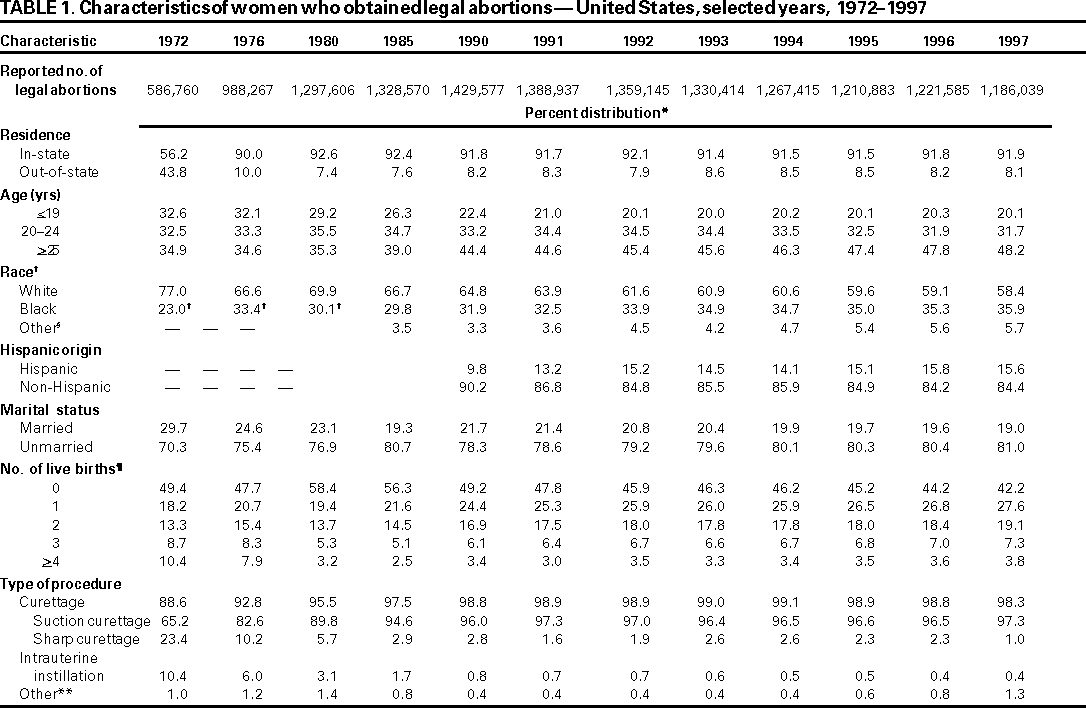 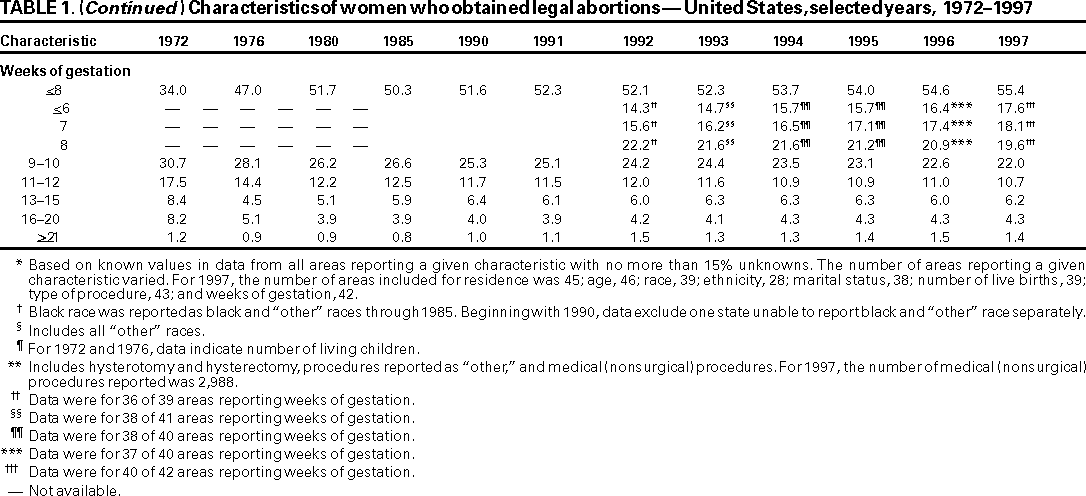 Return to top. Figure 1 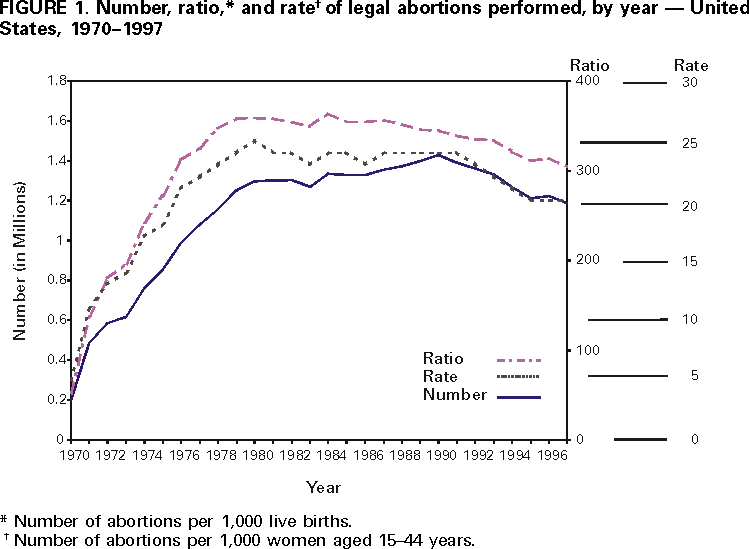 Return to top. Table 2 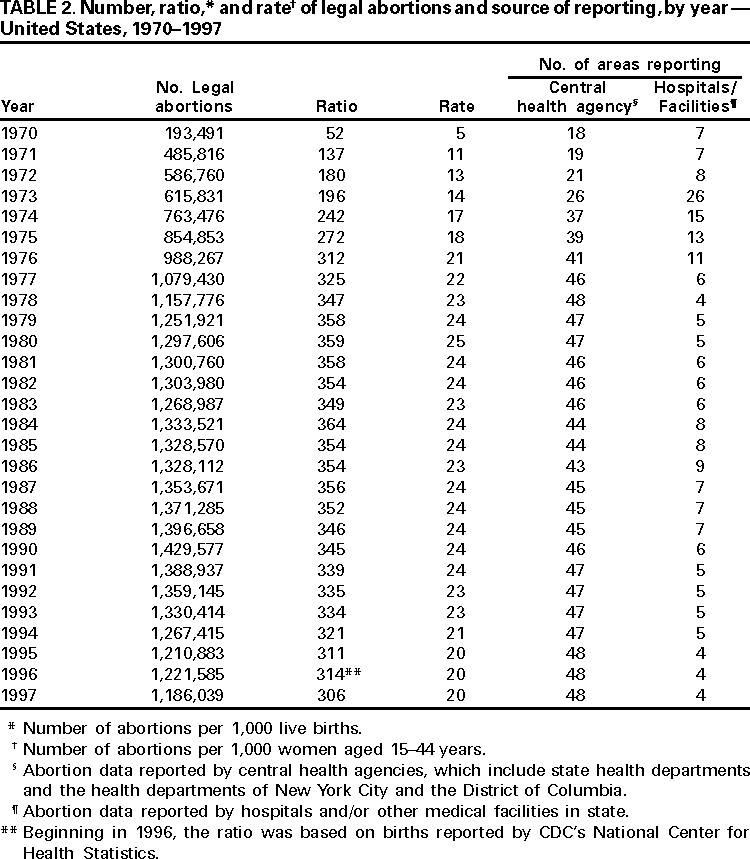 Return to top. Figure 2 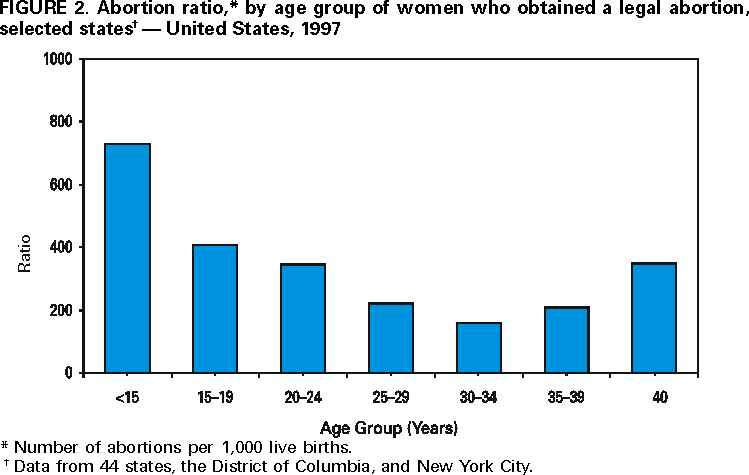 Return to top. Table 3 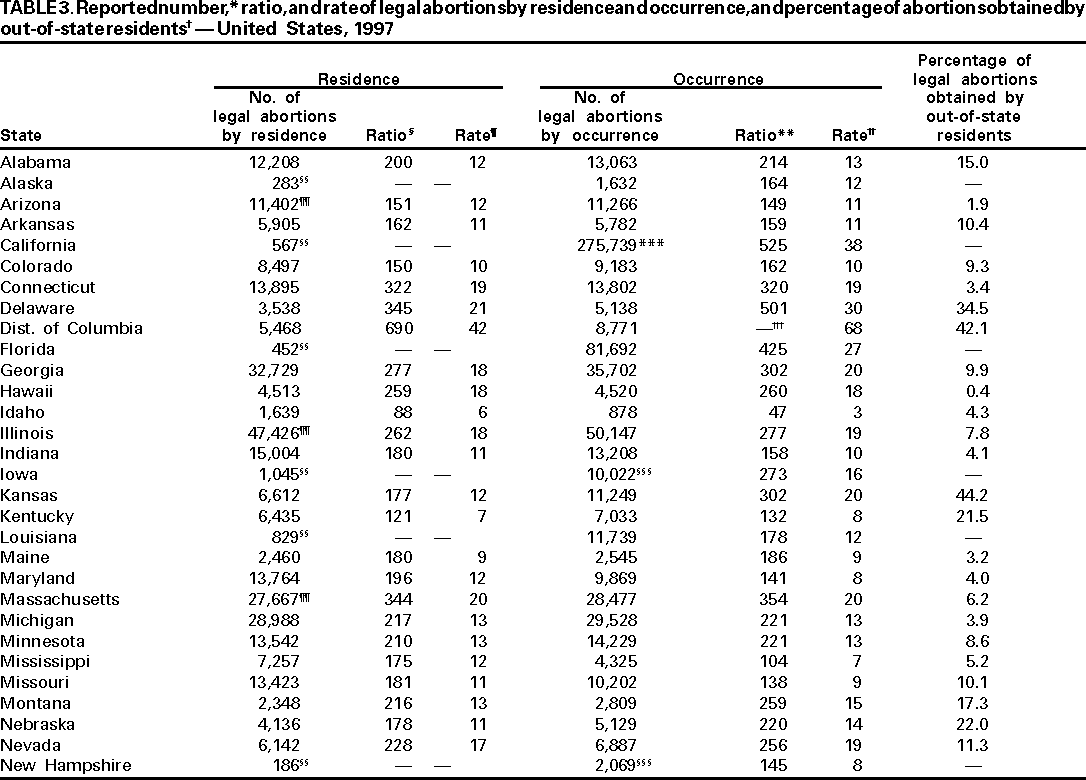 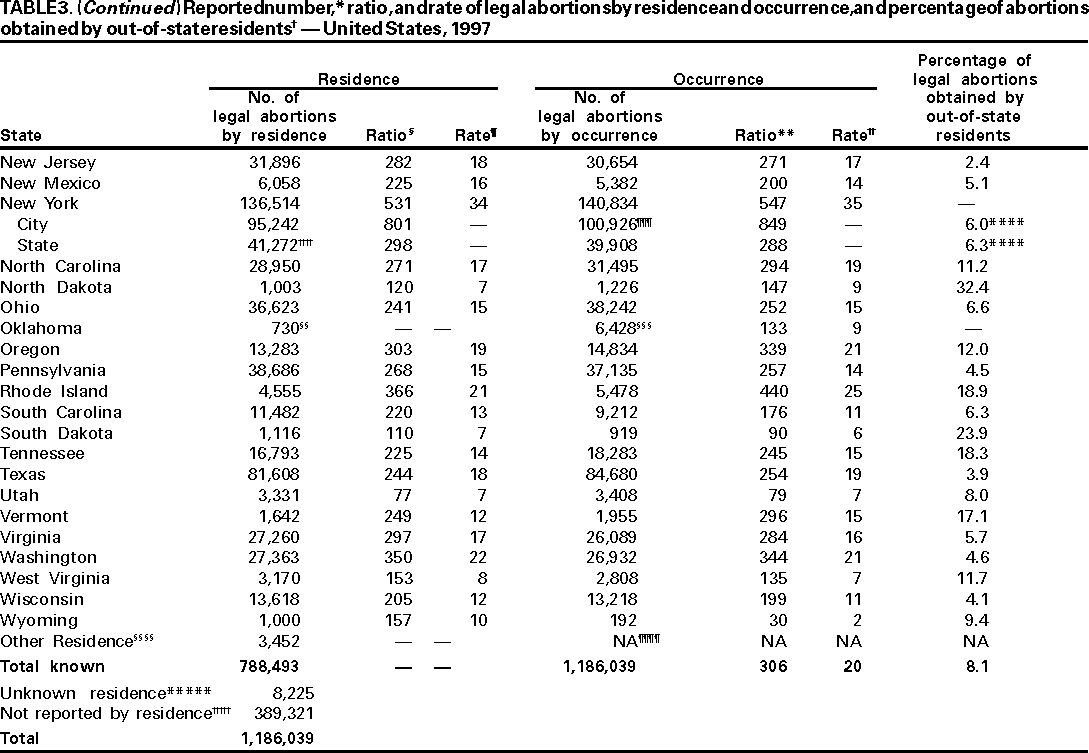 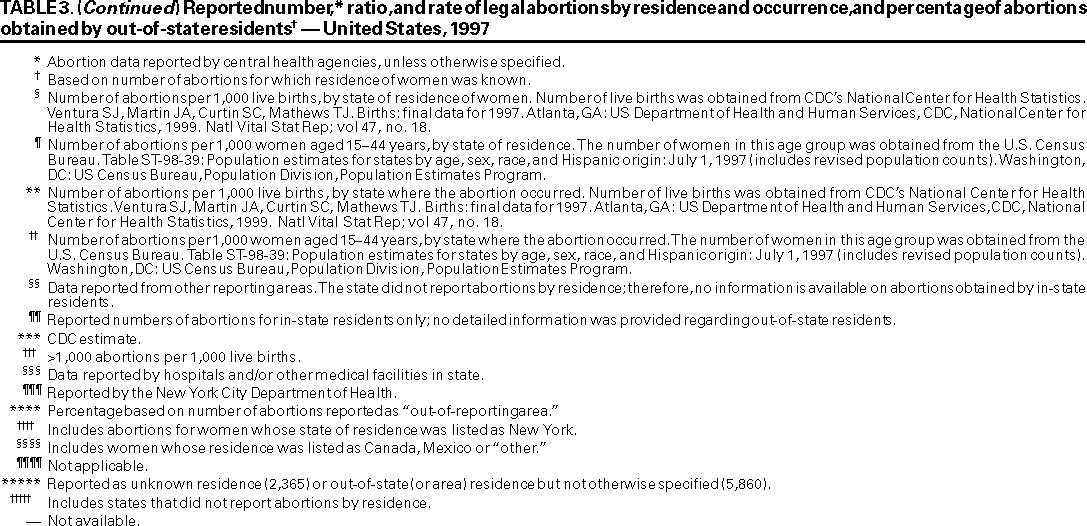 Return to top. Figure 3 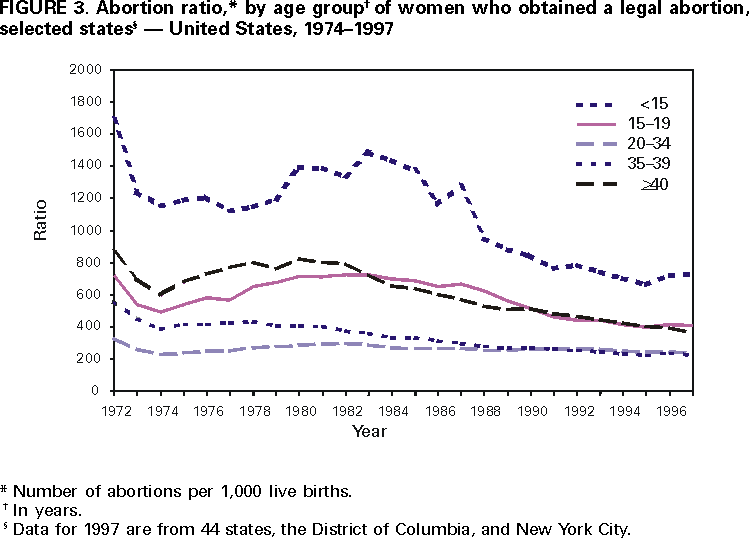 Return to top. Table 4 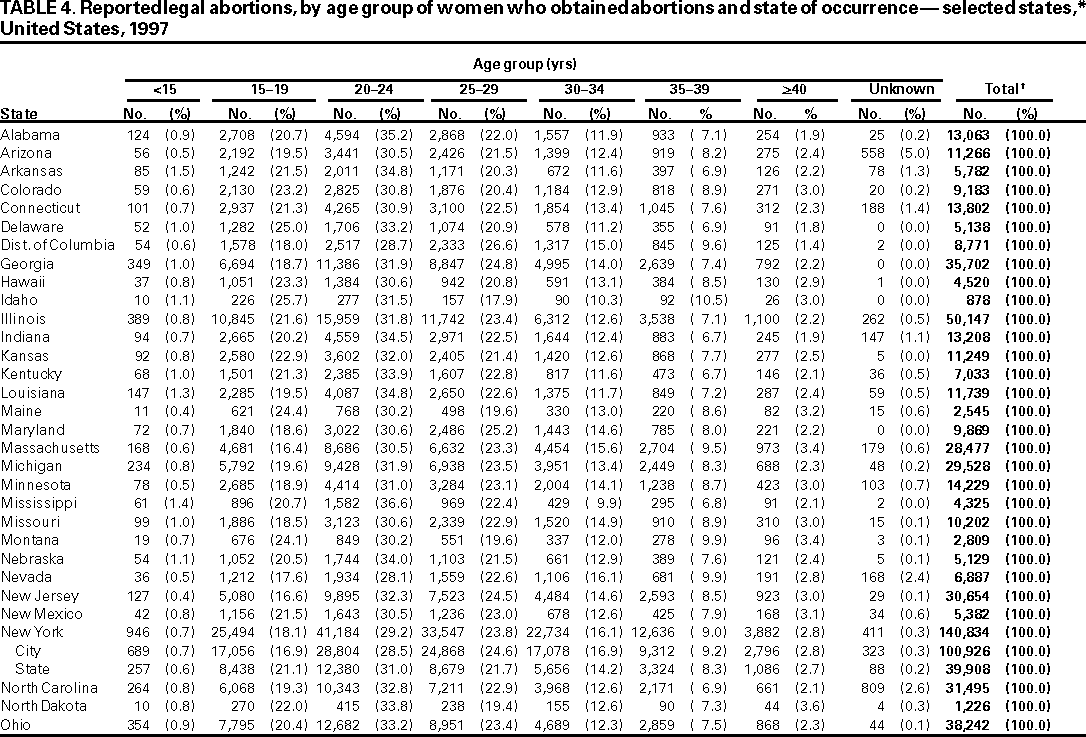 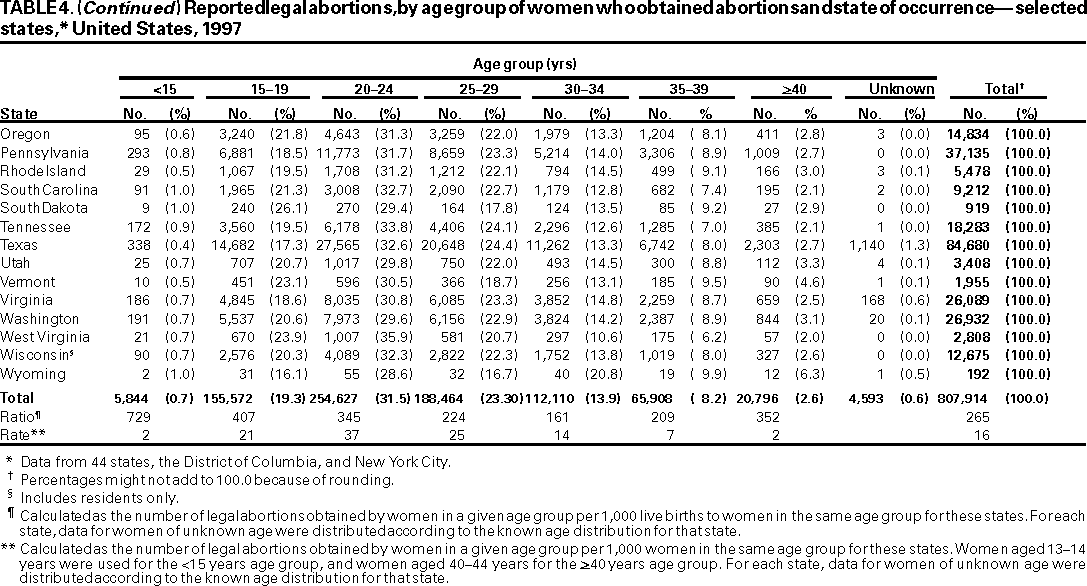 Return to top. Figure 4 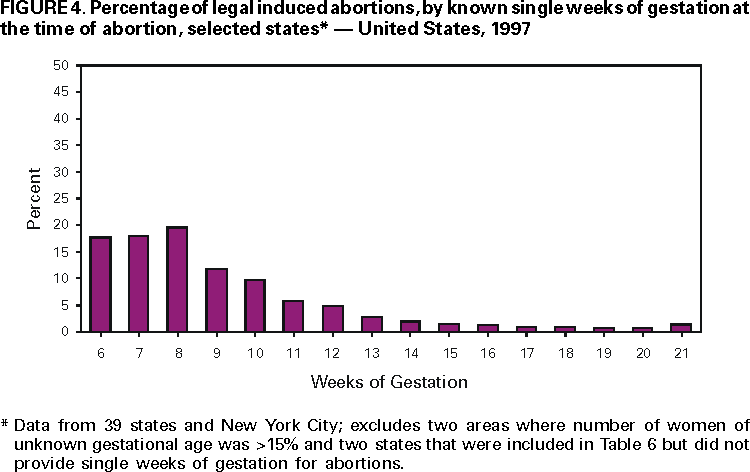 Return to top. Table 5 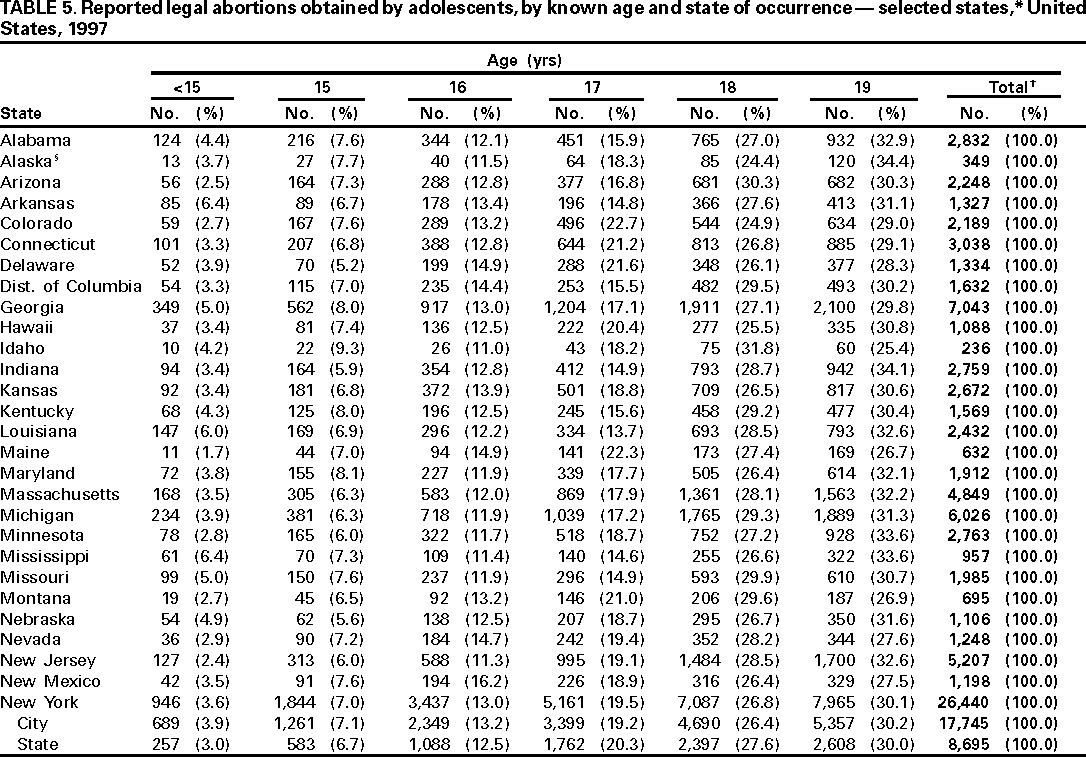 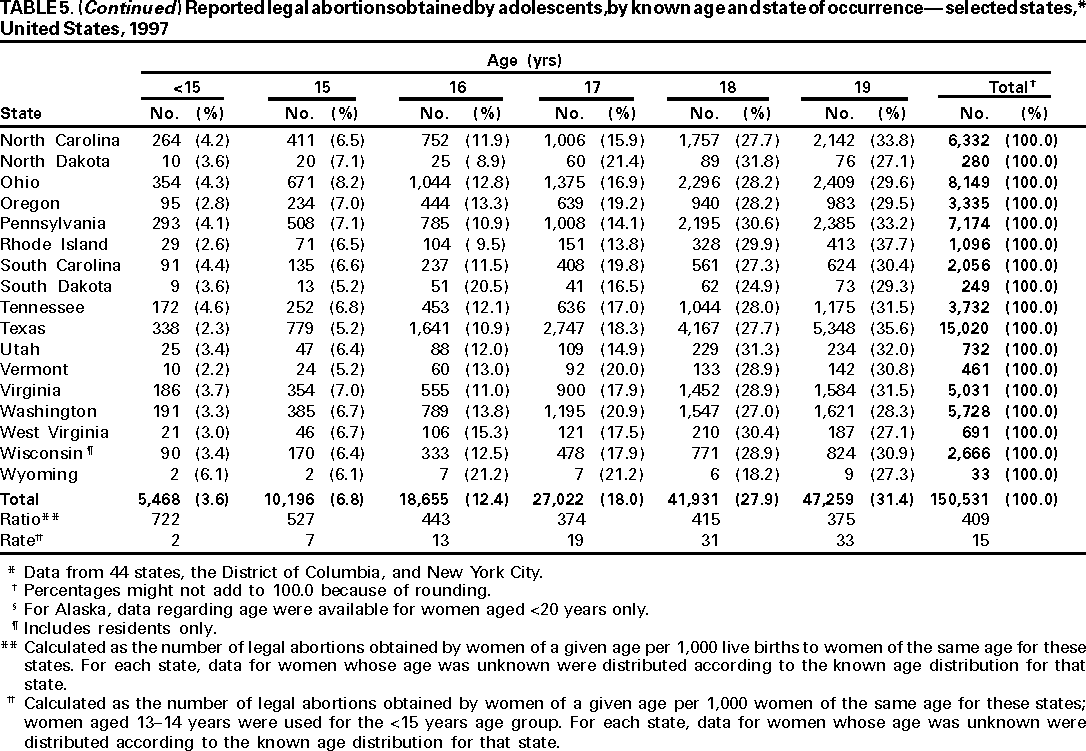 Return to top. Figure 5 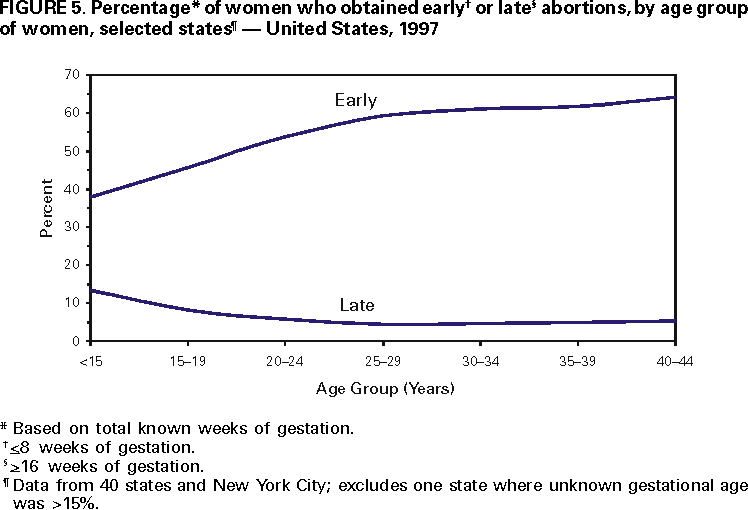 Return to top. Table 6 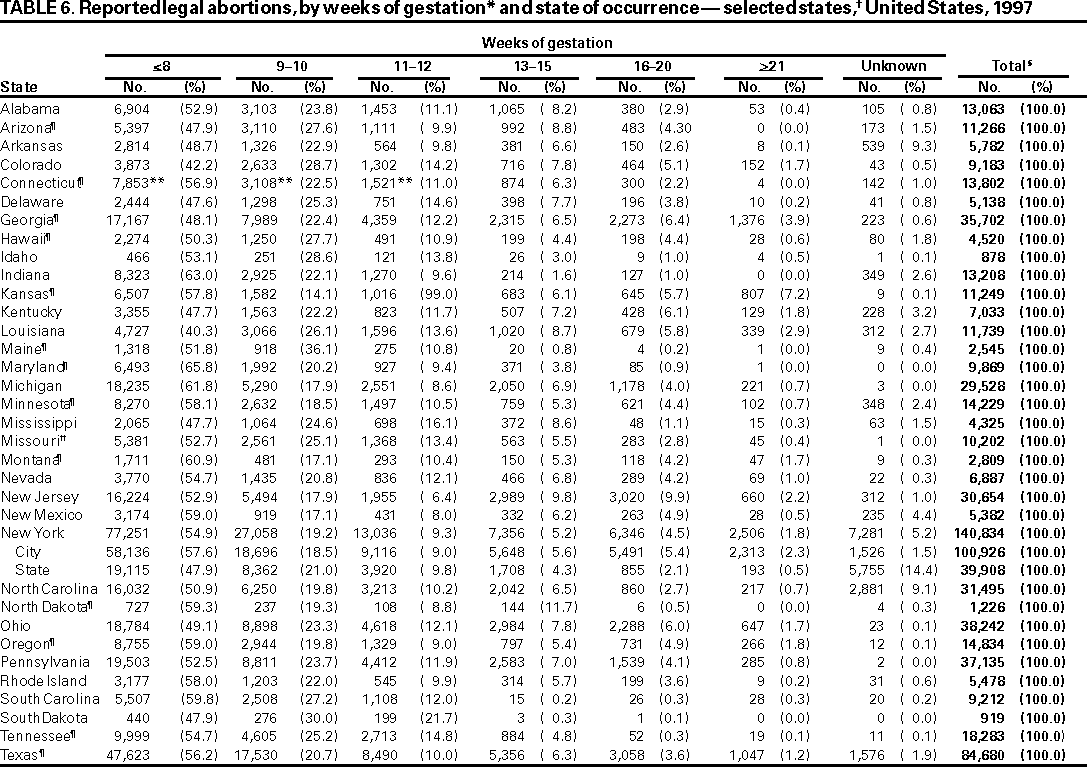 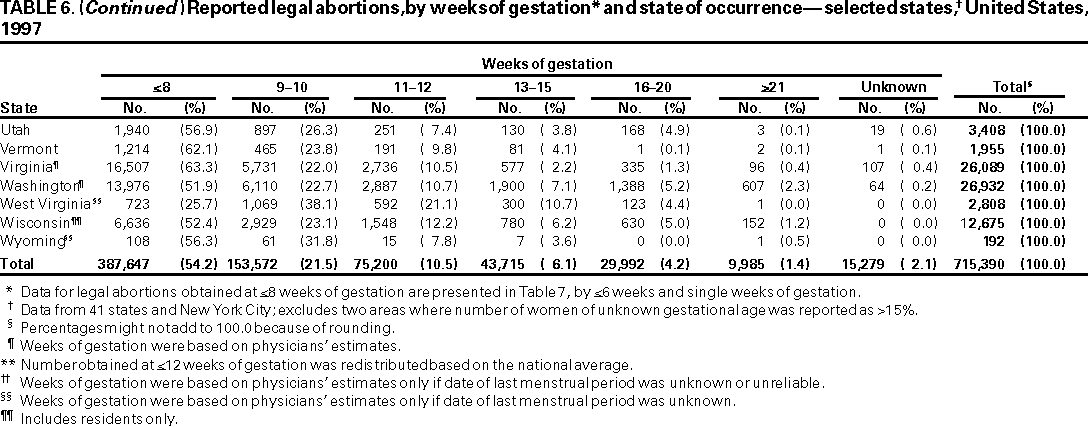 Return to top. Table 7 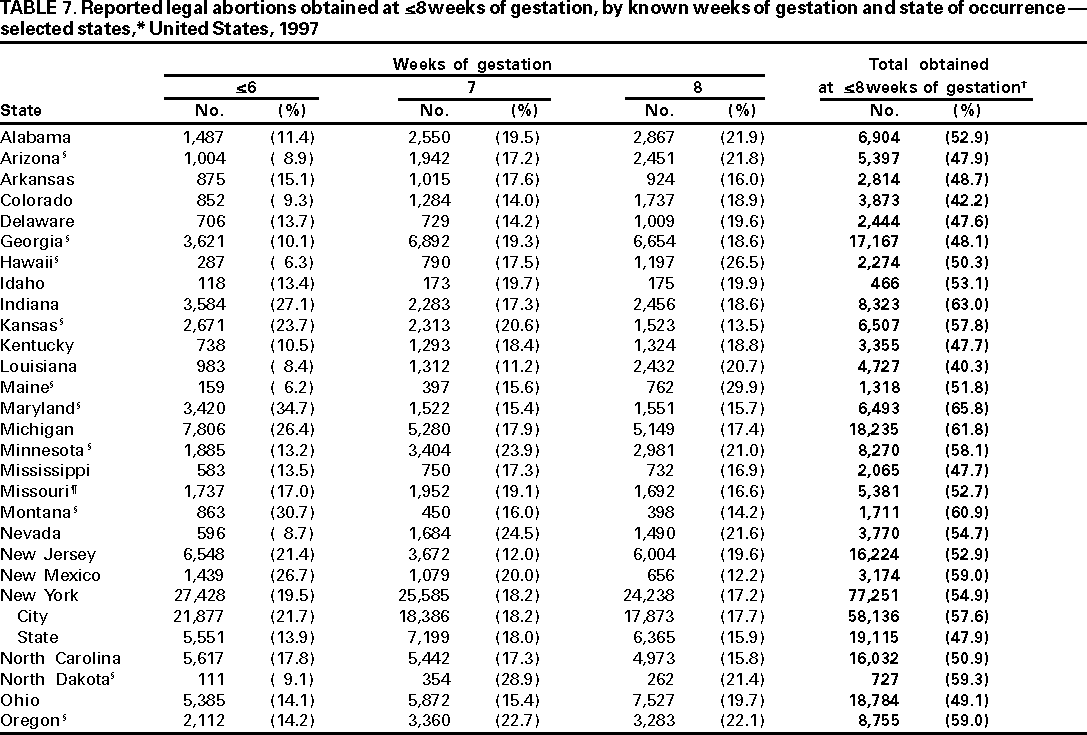 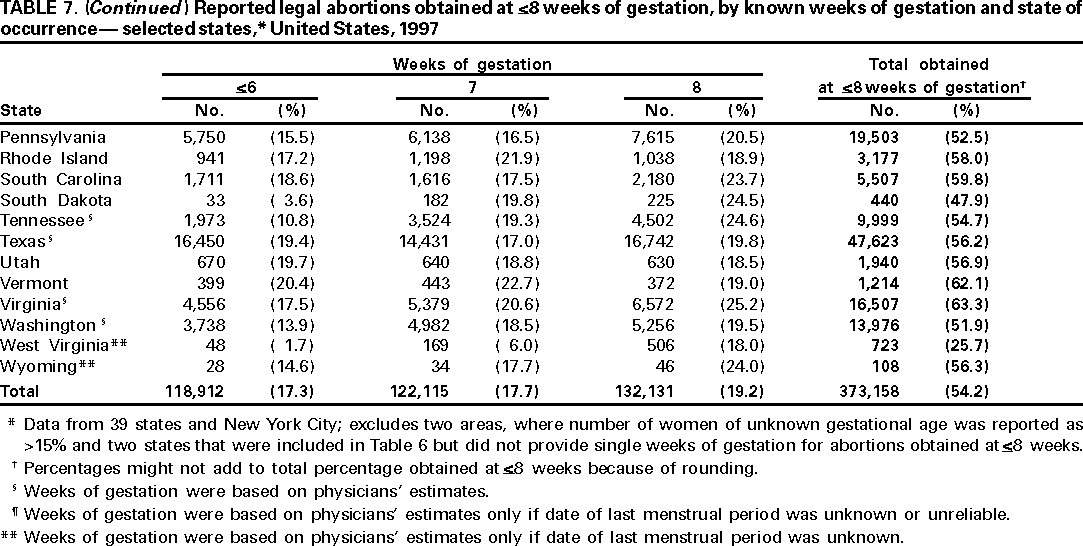 Return to top. Table 8 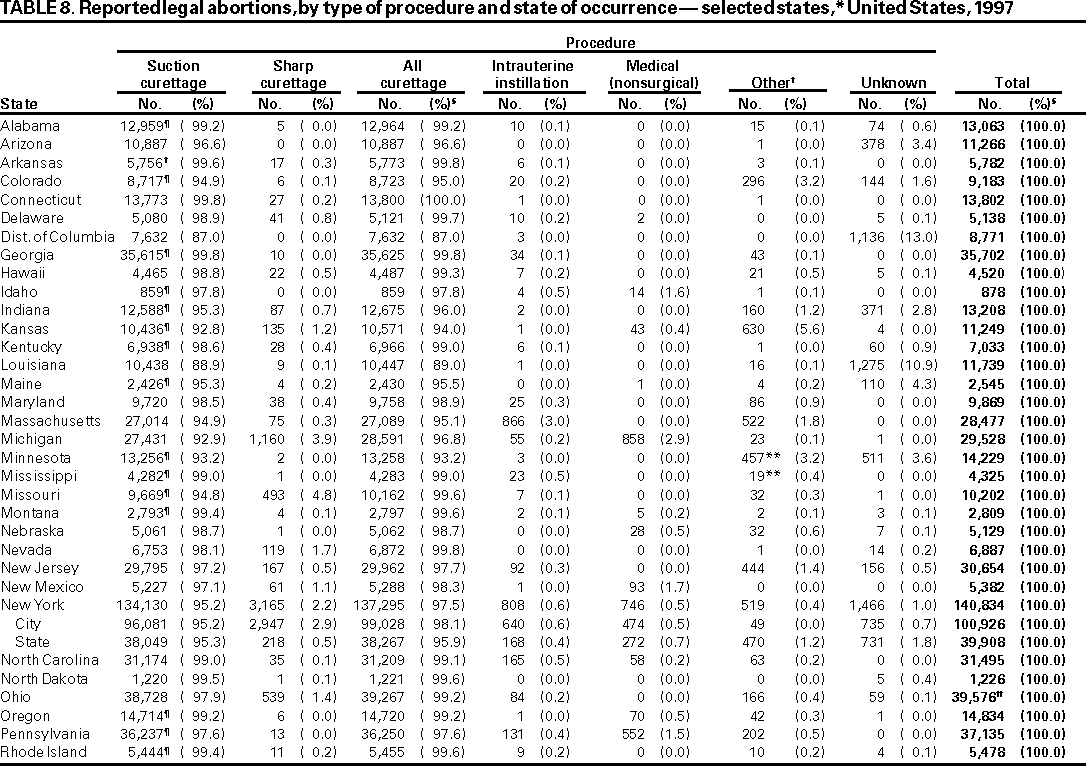 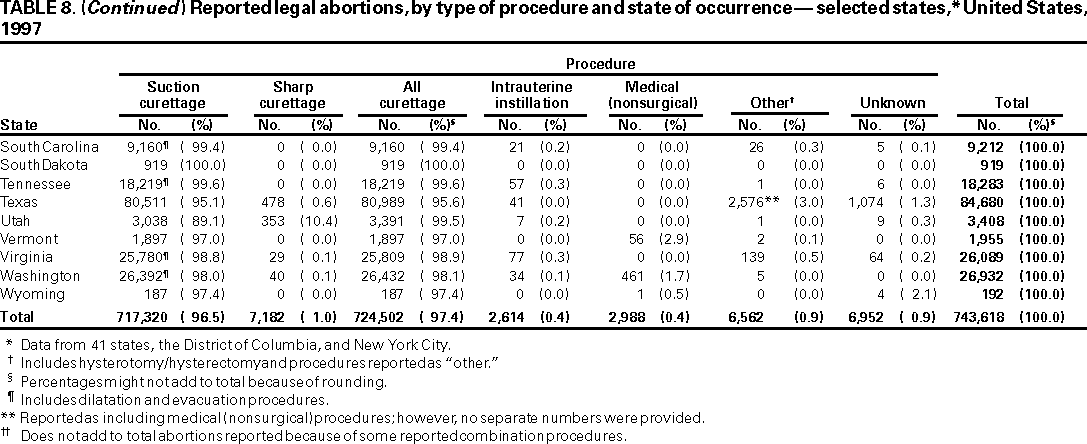 Return to top. Table 9 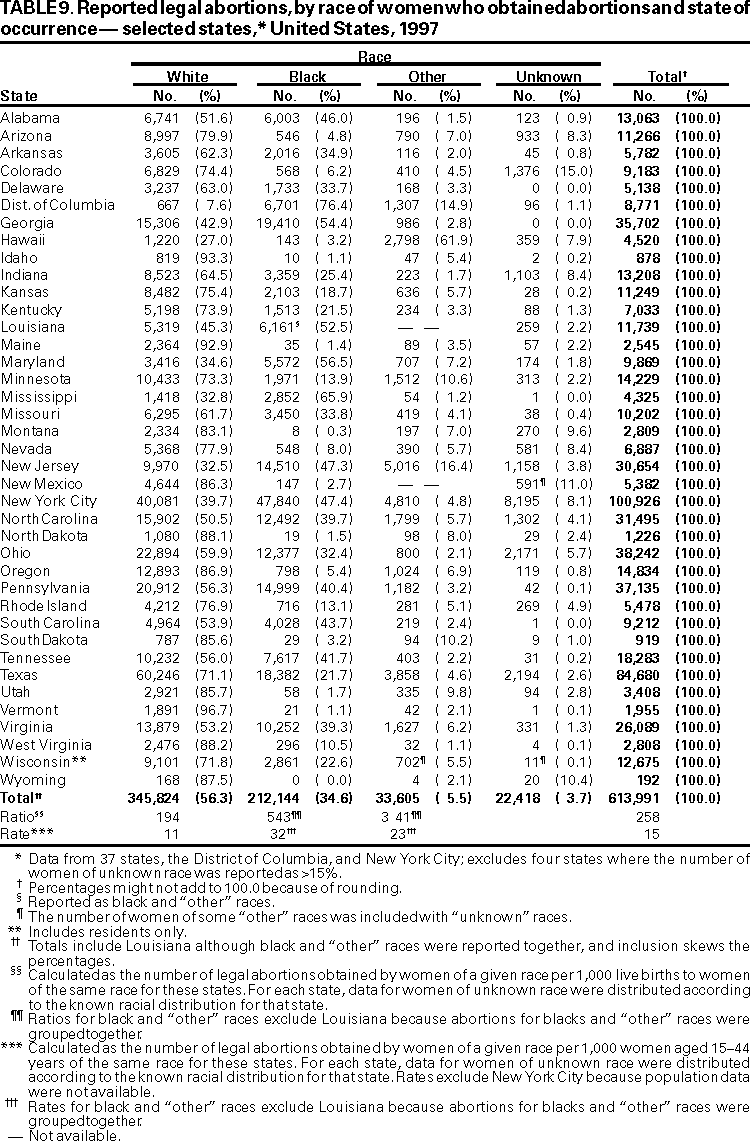 Return to top. Table 10 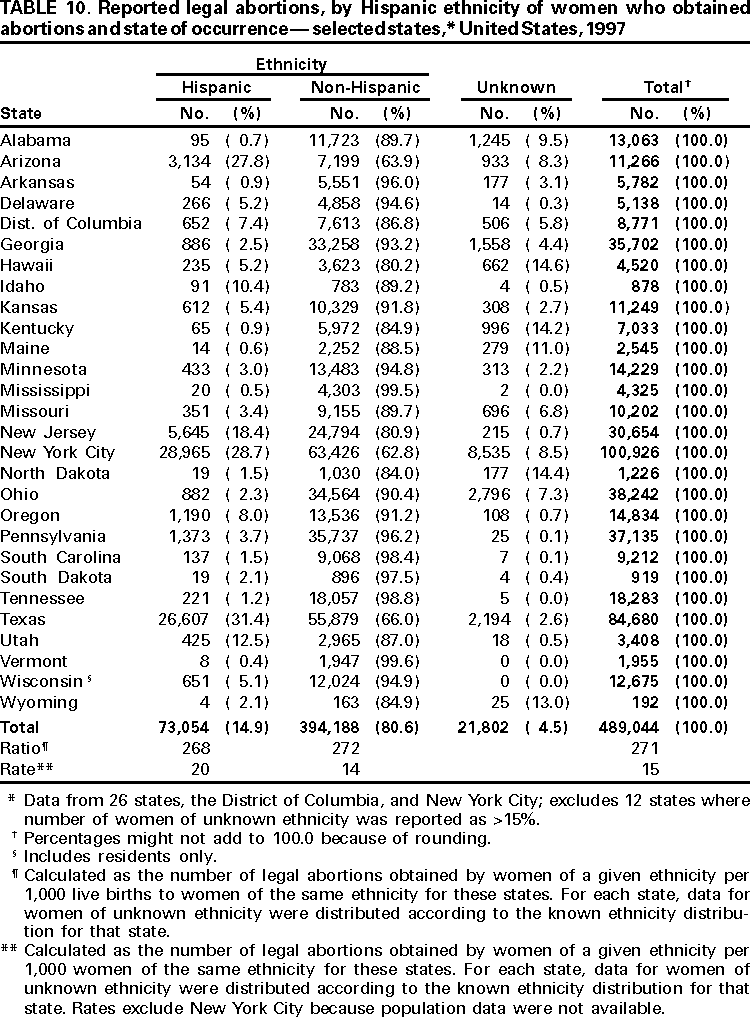 Return to top. Table 11 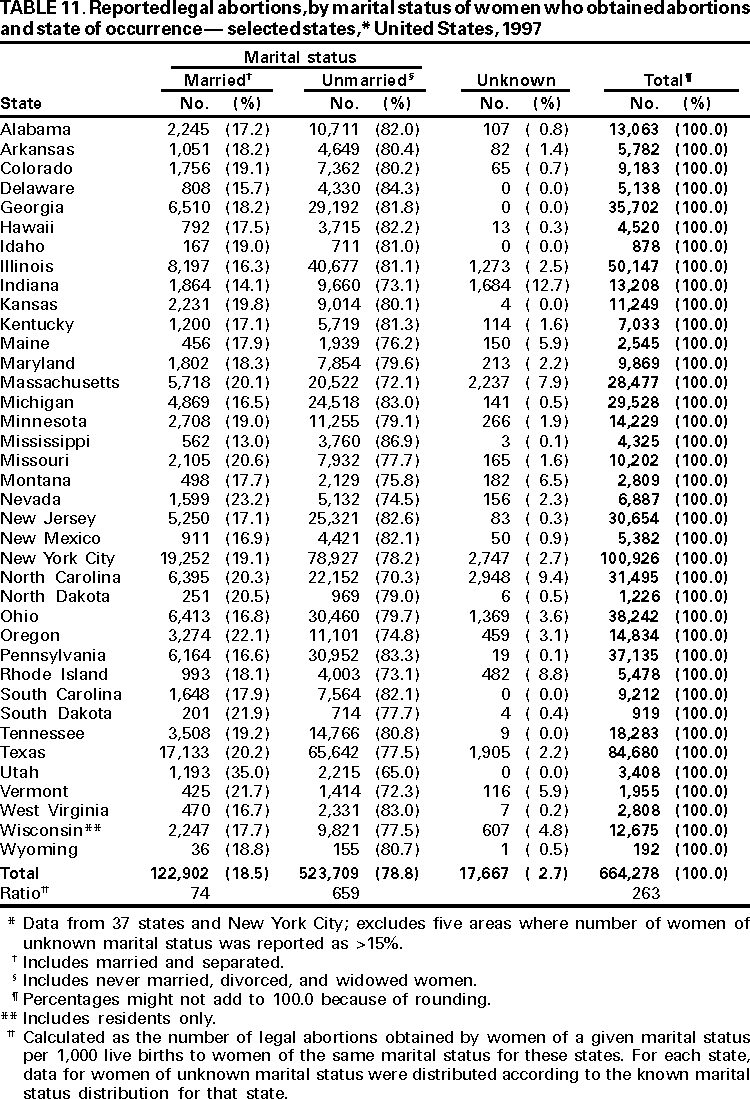 Return to top. Table 12 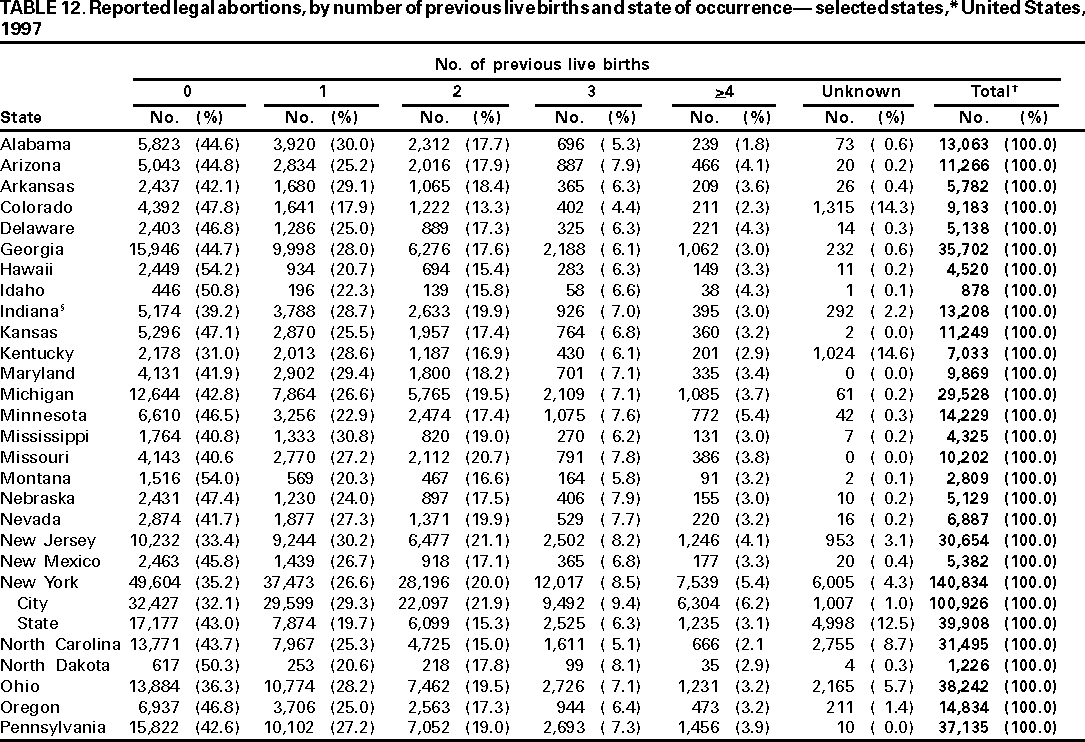 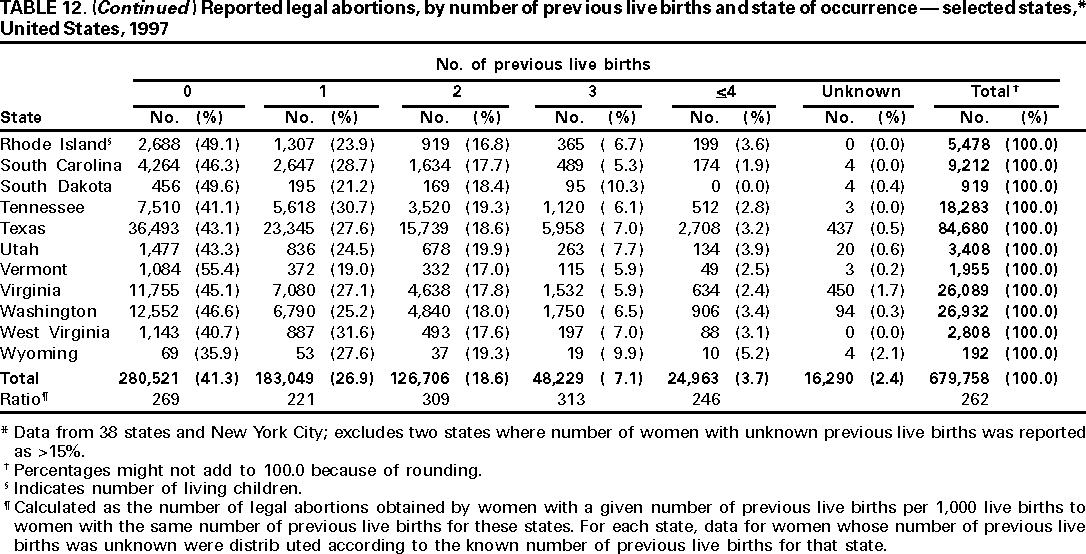 Return to top. Table 13 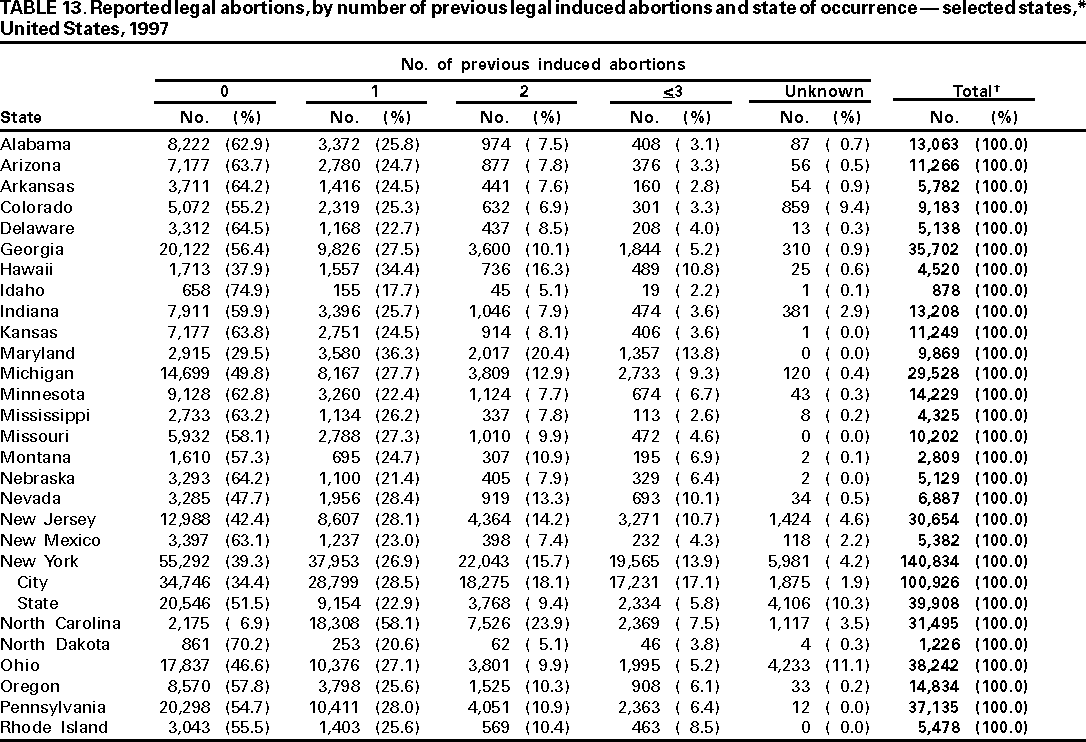 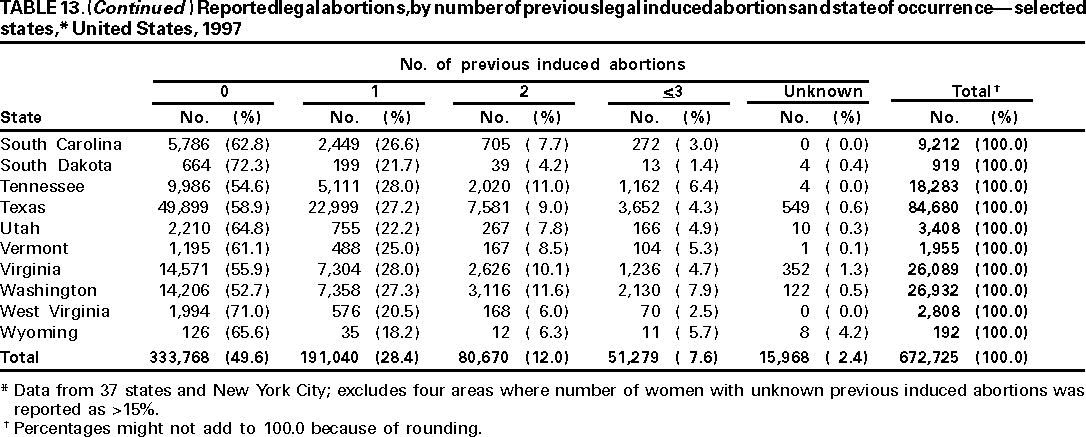 Return to top. Table 14 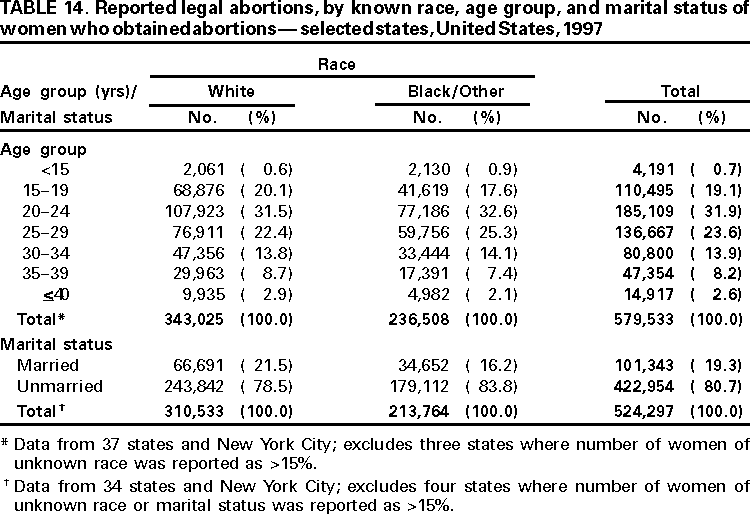 Return to top. Table 15 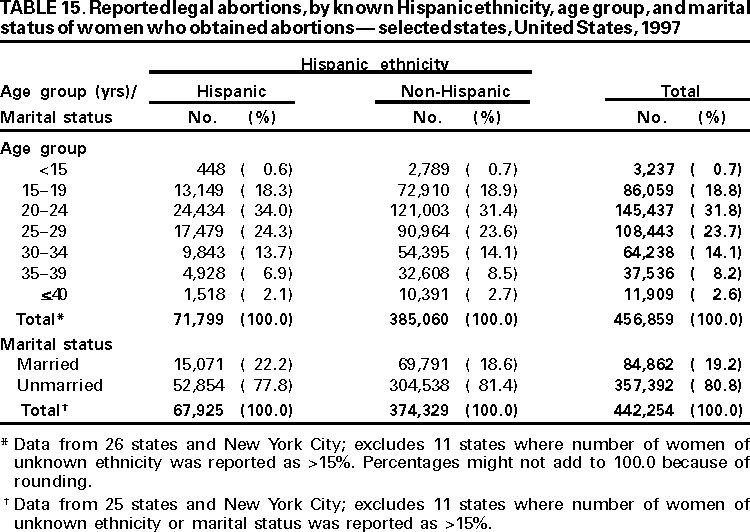 Return to top. Table 16 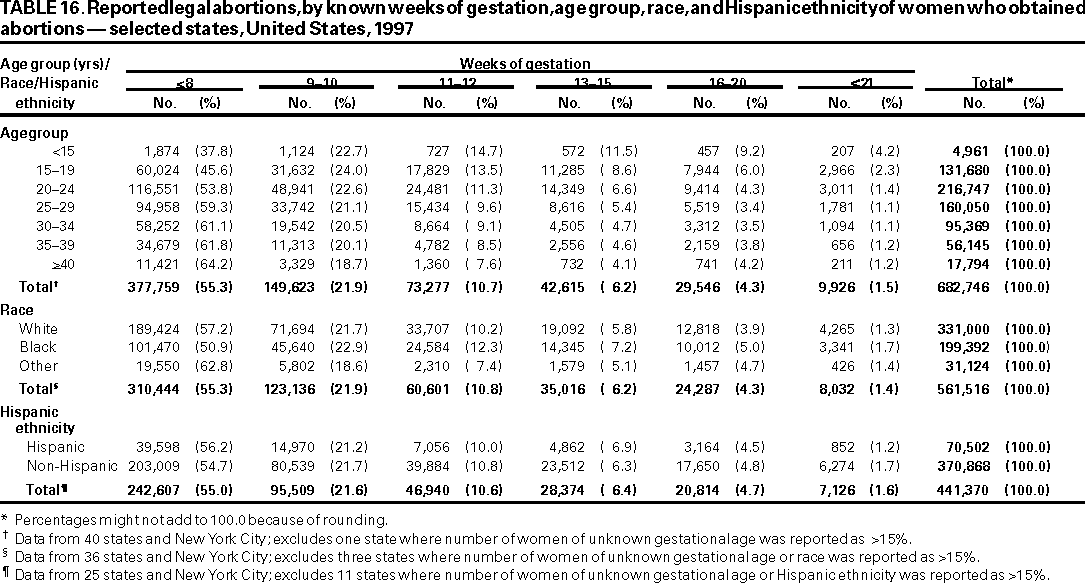 Return to top. Table 17 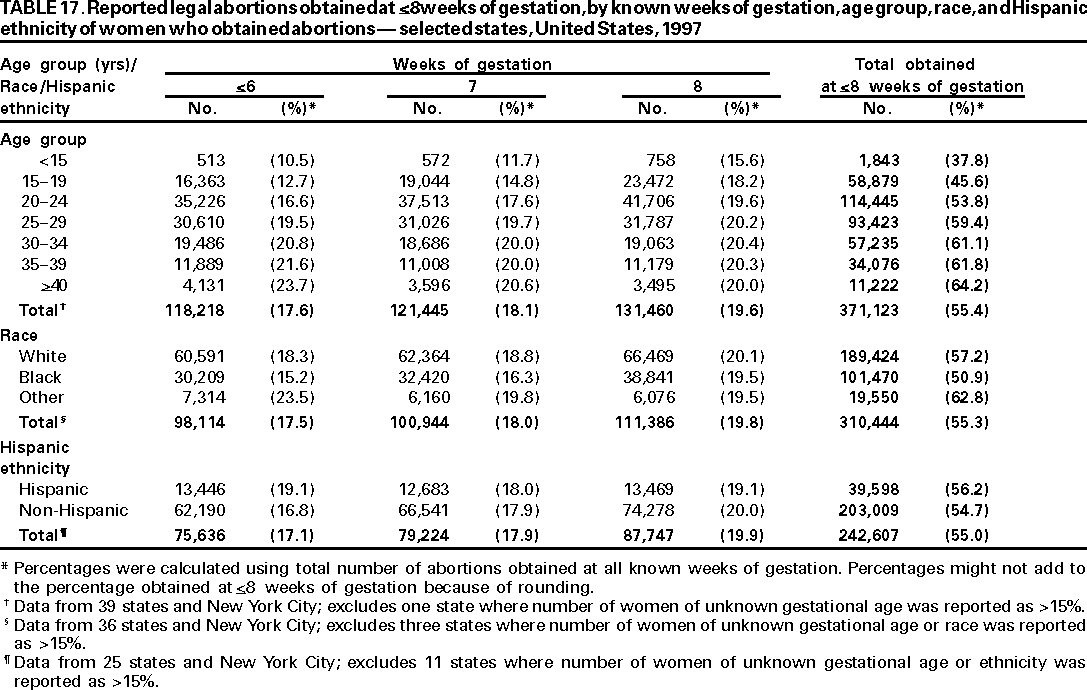 Return to top. Table 18 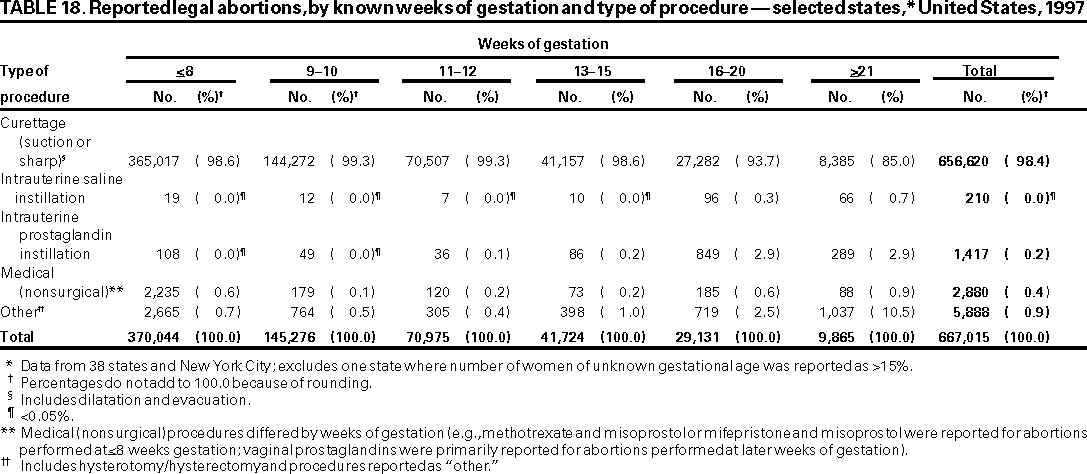 Return to top. Disclaimer All MMWR HTML versions of articles are electronic conversions from ASCII text into HTML. This conversion may have resulted in character translation or format errors in the HTML version. Users should not rely on this HTML document, but are referred to the electronic PDF version and/or the original MMWR paper copy for the official text, figures, and tables. An original paper copy of this issue can be obtained from the Superintendent of Documents, U.S. Government Printing Office (GPO), Washington, DC 20402-9371; telephone: (202) 512-1800. Contact GPO for current prices. **Questions or messages regarding errors in formatting should be addressed to mmwrq@cdc.gov.Page converted: 12/7/2000 |
|||||||||
This page last reviewed 5/2/01
|